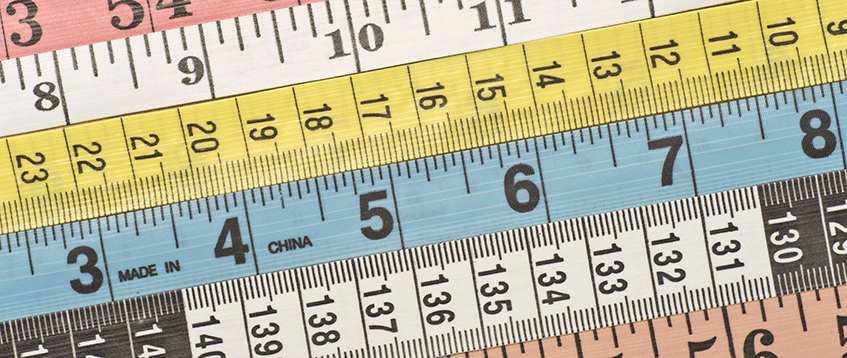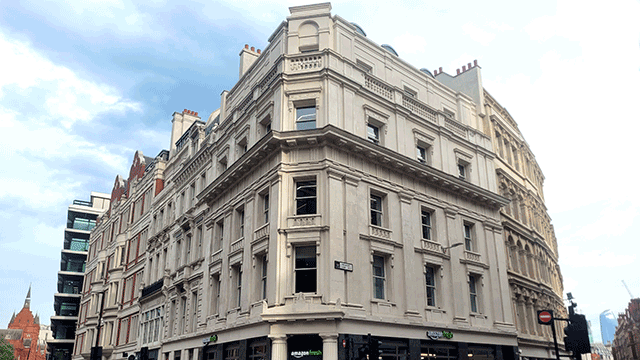Measurement is a core skill for surveyors (see “How do you measure up?”) and formal guidance for the profession is found in the RICS Code of Measuring Practice (6th edition, 2018).
While this column does not address the code itself, it explores some of the more fundamental aspects of space-related measurement both outside and inside buildings.
All land and property-related students (and prospective APC candidates) should have a firm grasp and appreciation of the size and scale of things. Irrespective of Brexit, we will continue to work in both imperial and metric measurement.
“Est modus in rebus” means “there is measure in all things”. The motto features on the heraldic coat of arms of the RICS, under a measuring chain falling from the feet of a blue “lion passant guardant”, enclosing the capital of a classical ionic column. The two golden lions to each side of the chain are holding ranging rods, also used to measure land.
What is a measuring chain?
A measuring chain (and a chain is a unit of measure) is 66ft (22 yards) long. Eighty chains is equal to one mile. In surveying terms, the chain is also known as a Gunter’s chain, so named after Edmund Gunter, a 17th-century mathematician, astronomer and clergyman. They are not really used in practice now, but could be when needs be.
A one-storey 20,000 sq ft light industrial unit is situated on a one-acre plot. Approximately how much of the site – in percentage terms – does the building take up?
This is a question that all qualified surveyors should be able to answer.
What do you need to know to answer this? Answer: the number of square feet in an acre. If you do not know this, you cannot answer the question. In the same way, if you do not know this number, the countless adverts in this magazine for the sale of development land are somewhat meaningless.
A typical advert might say: “Former commercial site of approximately 4.68 acres. Fantastic location within walking distance of the town centre. Proposed development of 104 dwellings and 30,000 sq ft of office accommodation…”
Once again, not knowing how many square feet are in an acre without looking it up (and you should not need to as a qualified property surveyor), means that you cannot understand the housing and commercial opportunity on sale. So how many square feet are there in an acre? Answer: 43,560. All students should commit this number to memory. Thus, the answer to the first question regarding the light industrial unit is roughly 50%.
Another question to consider is: how long would the sides of an acre be if the area was set out as a perfect square? The answer is the square root of 43,560, which is 208.710325571! (or c. 209ft).
Why does our English (and the American) imperial measurement system give such a strange number as 208.710325571 as the side of a square acre?
This is because an acre, as an area of land, was not conceived of as a square. An acre of land in medieval times was reckoned to be an area of land that could be ploughed by a team of eight oxen in one day. In terms of measurement, this was settled as an area that was 66 feet wide (one chain – as referenced in the RICS coat of arms) and 660ft long (one furlong, derived from the words “furrow” and “long”). 66 x 660 of course makes 43,560. It is also worth knowing that eight furlongs make a mile.
How big is an acre in relation to familiar areas of land?
Football pitches vary in size, but regulation-size pitches are 300-390ft long and 150-300ft wide. Taking a 330ft by 210ft layout, the pitch would be 69,300 sq ft, or approximately 1.6 acres in size. A netball court is much smaller at 100ft by 50ft, which would equate to approximately 0.1 acres.
What about metric measurements?
The great thing, of course, is that there are a lot of noughts in metric measurements. The hectare as an area of land that if set out as a perfect square would have sides of 100m, and therefore has an area of 10,000 sq m. A hectare is easier to picture if you imagine a 100m running track with Usain Bolt sprinting from start to finish in just under 10 seconds. It is also worth remembering that the grass area inside a 400m running track has an approximate area of around 1.1 hectares.
Imperial to metric conversions
The first thing to remember is that hectares are bigger than acres. The conversions from one to the other are as follows:
- 1 acre = 0.405 hectares
- 1 hectare = 2.471 acres
Also, try to remember that 1ft is equal to one-third of a yard, or 0.3048m.
What about square feet to square metres and vice versa? Very approximately, you can divide or multiply by 10. An office floor in Marylebone, London, is currently up for rent. The advertisement states that it covers 10,226 sq ft, which is 950 sq m. Why is this roughly a multiple or division of 10? A metre is the equivalent of 3ft 3.37in. A square metre is thus equal to 10.76 sq ft. A square foot is equal to 0.093 sq m – all very close to 10 or a tenth.
As a student and graduate surveyor, you must understand and be able to work with both measurements. You will encounter both in practice, even though metric was formally endorsed in 1965 as the way forward. Planning authorities, for example, use metric but the housebuilding industry still uses imperial measurements.
How big should somewhere to sleep be?
Let us examine the size of some typical residential spaces. If you are renting a property as a single person, the bedroom you occupy must (by law) be no smaller than 6.51 sq m, or 70 sq ft – that would be a square with sides of 2.55m, or 8ft 4in. A single bed is approximately 0.9m x 1.9m.
How big is your bedroom? If you don’t know, measure it. At Heriot-Watt University, a single study bedroom with a 4ft-wide bed and en-suite toilet and shower is 16 sq m.
What is the average size of a new home?
The average size of a new home in Britain is currently around 68 sq m, or 732 sq ft, and since the 1970s it has decreased. Main living rooms in new homes in particular have got smaller.
New homes in Britain are also smaller compared with those in many other EU countries. In 2015, the government set out space standards for one- to six-bedroom new homes (see the table, below).
What about office and study space?
Office sizes can vary from a one-person workstation to One Canada Square (the tallest building at Canary Wharf in London’s Docklands), which has a total floor area of 1,748,296 sq ft, or 162,422 sq m over 50 floors. However, what is important to understand is how many staff can or should occupy a given area.
There are legal minimums as to areas of space per person. Regulation 10 of the Workplace Regulations 1992 requires for the purposes of health, safety and welfare that each person has 11 cubic (rather than square) metres of space. This means that in a typical office where the ceiling height is 2.4m, a floor area of 4.6 sq m is needed, equating to, say, 2m x 2.3m. The old minimum used to be 40 sq ft (3.7 sq m).
In practical terms, a desk, chair, space for some storage and immediate space for personal movement would take up 5-7 sq m. If all communal areas were taken into account, that might mean an area of approximately 8-12 sq m per person, but it depends on the type of organisation and building.
The important thing to remember is that it is approximately 10 sq m per person and not 3 sq m and not 33 sq m. An excellent resource that covers office, laboratory and study space can be found here.
Time spent working through this document and comparing where you study or work will be time well spent in learning the basics about space.
Let’s go shopping
Thinking about the big supermarkets, how big are they? Tesco Metro stores are (back to imperial again) typically 7,000-15,000 sq ft of sales area. The retailer’s superstores are 20,000-50,000 sq ft of sales area.
Asda supermarkets are 10,000-25,000 sq ft, its superstores are around 44,000 sq ft and its supercentres are about 85,000 sq ft.
Aldi, by comparison, has an average store size of some 10,000 sq ft. In London, it was recently seeking sites for new stores of 16,500 sq ft, with an area for a minimum of 70 car parking spaces. So what size of site might be the minimum Aldi is looking for? To calculate this, we also need to know how big an area 70 car parking spaces would cover, plus circulation space. You could start by going to DecoSoup, and then try and work it out, but do not forget disabled parking needs.
The government planning website has some guidance on designing for an accessible environment.
The answer to this question is that a minimum of one acre would be needed. To understand this better, sketch a site and make your own calculation of what area might be needed.
Final thoughts
For many, seeing and having a feel for the measurement of space is not easy. Knowing the size of familiar objects and spaces is a good way to build skill and confidence.
Start with the space you are in and the things in it, and when outside estimate the width of a pavement and the distance from one side of the road to the other. Do this from a plan too. Find a big space that you know well and find out how big it is and use it as a reference point in your mind in looking at other spaces. It could be a town square, a village green or a sports field.
Size does matter…
If you are looking at this article in hard copy, what is the paper size? You might know it is A4, but how big is A4? It is probably not what you might think. It is 210 x 297mm. But why such odd dimensions? If you still have enough numerical energy left, you can read up on this here and here.
Paul Collins is a senior lecturer at Nottingham Trent University and Mainly for Students editor. He welcomes suggestions for the column and can be contacted at paul.collins@ntu.ac.uk











